How to Research a Bill Using LegInfo
Contents
Search
You can look up your favorite bill by its number at bit.ly/CAbillsearch.
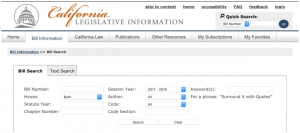
Type the bill number into the input area and click Search. If you are searching for a bill from a previous legislative session, change the Session Year from 2017-2018 to the correct one.
Select the correct bill from your results. If there is only one match, you’ll be automatically redirected to the bill.
You’ll notice that the bill page has the following tabs:

Here is what the tabs contain:
- Text – Authors, co-authors in both houses, the text of the bill, with amendments highlighted.
- Votes – Dates, where votes took place (committees or on the house floor), and how each rep voted.
- History – Every official action related to the bill.
- Bill Analysis – Analyses written by the staff of each committee or the legislative chamber as a whole. These summarize current law, how the bill would change the law, and arguments for and against the bill.
- Today’s Law As Amended – Indicates how the current law would be changed if the bill takes effect.
- Compare Versions – Tool for checking any version of the bill against previous versions.
- Status – Facts about the bill in its current form.
- Comments To Author – Lets you send a comment to the author of the bill if you are logged into your account.
Text
The Text tab for AB 3131 looks like this:
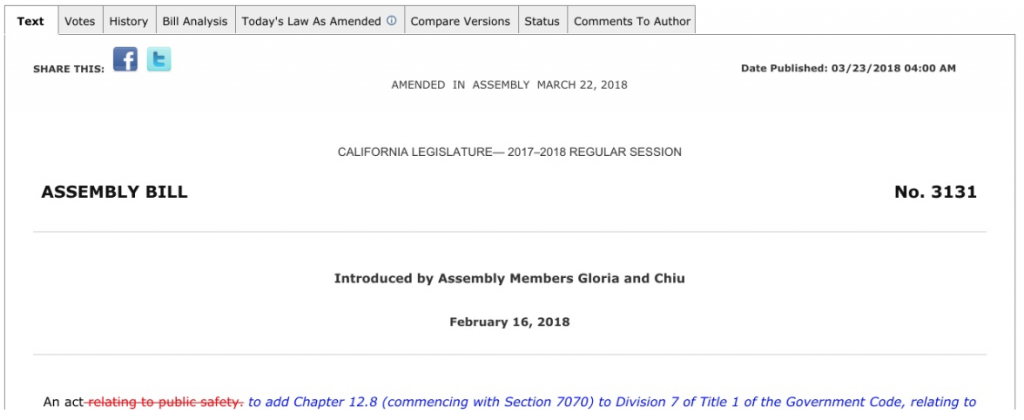
From this information, we can tell that Asm. Gloria is the first author of the bill,because he’s listed first. His staff will be in charge of the bill. To talk to a person about how to support the bill, start by calling the first author’s office and asking to speak to the legislative aide in charge of the bill.
The text of the bill shows the most recent changes with proposed additions in blue italics and proposed deletions in red strikeout.
The top text of the bill is a summary of the bill written by the Legislative Counsel. It can be easier to follow than the text of the bill itself, especially if there have been a lot of amendments.
The actual text of the bill is after “THE PEOPLE OF THE STATE OF CALIFORNIA DO ENACT AS FOLLOWS:”.

Above the horizontal line, you’ll see important information about the bill. AB 3131:
- Requires a 50%+1 majority (instead of 2/3) to pass a floor vote.
- Requires appropriations from the General Fund
- Needs to go to a fiscal committee, which will consider the bill’s financial impact, not the merits of its policies
- Imposes a new program on local governments, and therefore must be evaluated to see whether the state must reimburse local governments for costs incurred by the program
Status
The Status tab shows a bill’s progress at a glance.

Above, AB 3131 has had its first reading (official introduction) and is in its first policy committee.
Below, SB 54 has been through the entire legislative process and was signed into law.

Here’s what we’re seeing in this chart:
- In the Senate, SB 54:
- Went through its first reading (official intro)
- Went through a policy committee
- Had a second reading (official start of a 3-day period before a floor vote can happen)
- Had a third reading (the actual floor vote)
- Wasas pulled back for amendments
- Had another second and third reading
- Passed the Senate.
- In the Assembly, it went through a similar process. You can see that the bill must have been significantly amended because it went back to committees after being on the floor for a second and third reading.
The second red “Pass” means that the Senate concurred with the Assembly’s amendments. “Chp” means that the bill was chaptered, or made law.
The status page also shows a summary of important information, shown below:
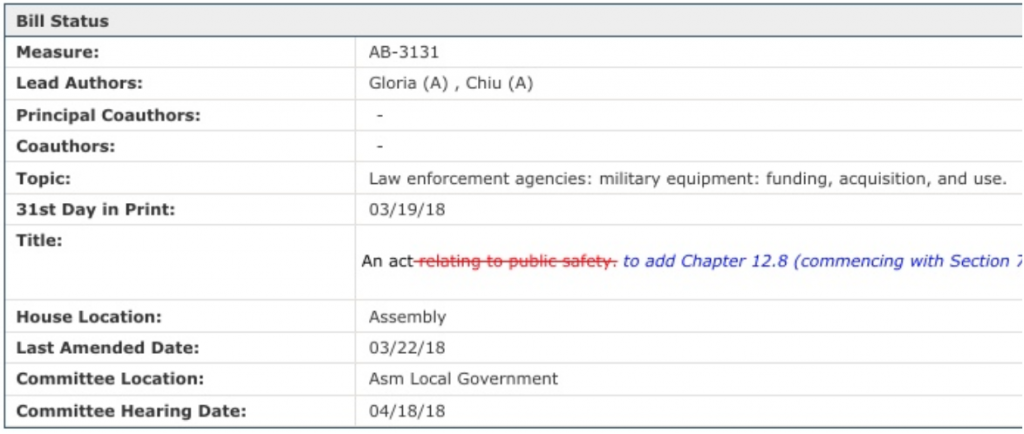
For us in California StateStrong, two of the most important bits of information here are the committee location and committee hearing date! Here, we see that AB 3131 has a hearing on 4/18 in the Assembly Local Government Committee. We need to take these actions:
- Write a call script.
- Find out who the committee members are.
- Ask constituents of those committee members to call them a day or two before the hearing.
We can also gather letters of support in advance of the hearing. That means taking these actions:
- Call the committee to figure out the deadline for letters to arrive and whether the committee will take PDFs or requires faxes.
- Write a template letter.
- Disseminate the template for other groups to edit with their own logo and information.
- Gather and send all the letters.
You can look up contact information for reps and committees in the Senate and Assembly.
History
The history tab shows action taken on the bill. Sometimes the information here doesn’t match the Status tab, which is confusing. 🙁

Votes
You can view the results of every vote taken on the bill. Here are votes for SB 54. The most recent vote is the concurrence vote in the Senate to approve amendments made in the Assembly, so it’s at the top.
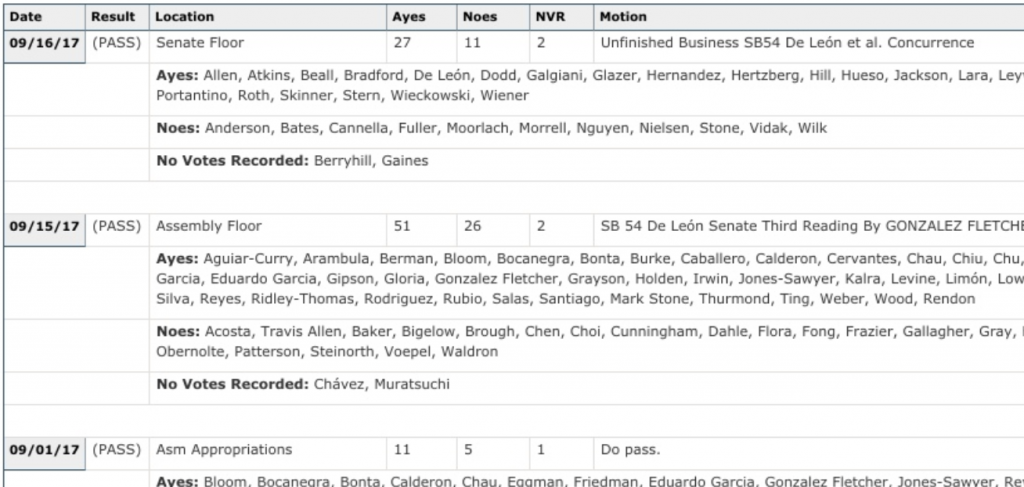
Bill Analysis
SB 54 went through many committees and was amended a bunch, so it has lots of analyses:
We find bill analyses easier to understand than the bills themselves. Each analysis is written by a staffer for a committee or legislative house, so it focuses on whatever the audience cares about.
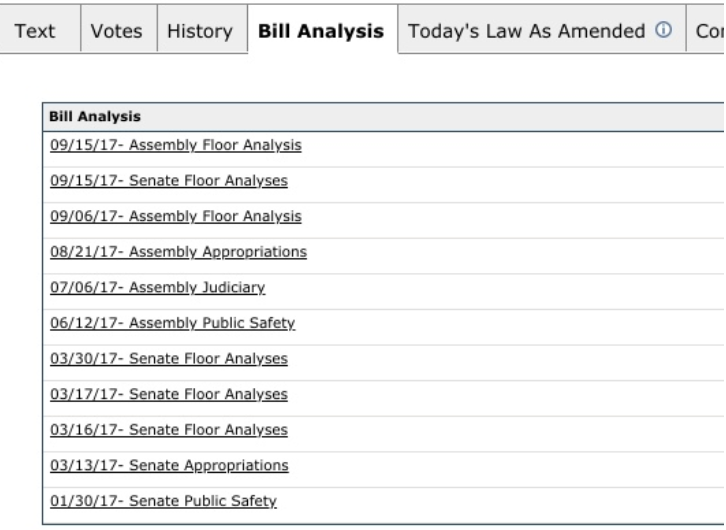
Typically, bill analyses explain the law as it stands and how it would change if the bill passed, and summarize arguments for and against the bill. If you submitted a particularly great letter of support (or opposition), it might be quoted in the analysis.
The names of organizations that submitted letters of support or opposition are listed at the end of the analysis. Sometimes logos are also present, NASCAR-style.
When you review these analyses, start with the latest (at the top of the list) to make sure you’re not reading one that has been made out-of-date by subsequent amendments to the bill.
